
Euphorbia is a very large and diverse genus of flowering plants, commonly called spurge, in the spurge family (Euphorbiaceae). "Euphorbia" is sometimes used in ordinary English to collectively refer to all members of Euphorbiaceae, not just to members of the genus. Some euphorbias are commercially widely available, such as poinsettias at Christmas. Some are commonly cultivated as ornamentals, or collected and highly valued for the aesthetic appearance of their unique floral structures, such as the crown of thorns plant. Euphorbias from the deserts of Southern Africa and Madagascar have evolved physical characteristics and forms similar to cacti of North and South America, so they are often incorrectly referred to as cacti. Some are used as ornamentals in landscaping, because of beautiful or striking overall forms, and drought and heat tolerance.

Euphorbia virosa, the Gifboom or poison tree, is a plant of the spurge family Euphorbiaceae. It has a short main stem, usually twisted, from which 5–10 cm branches emerge. These leafless branches have 5 to 8 edges. Paired thorns grow in regularly spaced intervals from the edges.
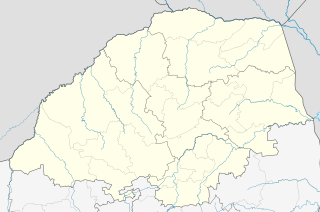
Mookgophong, also known by its former name, Naboomspruit, is a town in the Limpopo province of South Africa. The town is located approximately 42 km north-east of Modimolle and 51 km south-west of Mokopane.
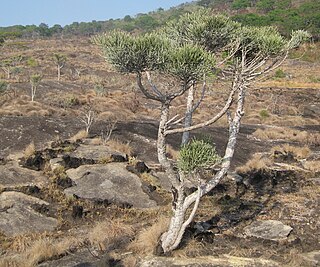
Euphorbia tirucalli is a tree that grows in semi-arid tropical climates. A hydrocarbon plant, it produces a poisonous latex that can cause temporary blindness.
Candelabra tree can refer to:
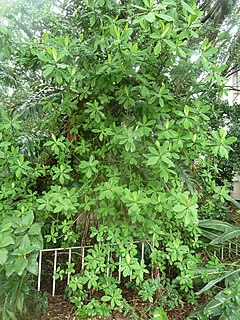
Euphorbia cupularis, referred to by the common name dead-man's tree is a succulent tree or shrub of the spurge family, Euphorbiaceae. It is found in South Africa and Swaziland.

Euphorbia arbuscula is a species of plant in the spurge family (Euphorbiaceae). It is endemic to the archipelago of Socotra in Yemen. Its natural habitats are subtropical or tropical dry forests and subtropical or tropical dry shrubland.
Bondo is a town in Siaya County of Kenya. It the largest town of the county. Bondo is located 50 kilometres west of Kisumu, the provincial capital. Bondo forms a town council with a population of 33,468.

Euphorbia candelabrum is a succulent species of plant in the family Euphorbiaceae, one of several plants commonly known as candelabra tree. It is closely related to 3 other species of Euphorbia in particular; Euphorbia ingens in the dry regions of South Africa, Euphorbia conspicua from western Angola, and Euphorbia abyssinica which is native to a number of countries including Sudan, Eritrea, Djibouti, Ethiopia and Somalia.

Euphorbia poissonii, also known as Euphorbia poissoni and, incorrectly as Euphorbia poisoni is a highly irritant and toxic succulent member of the large and varied spurge family of plants. It is native to northern Nigeria, where local farmers extract its latex for use as a pesticide. Its powerfully irritant and pain-producing nature mandates use as a fencing plant.

The Euphorbiaceae are a large family, the spurge family, of flowering plants. In common English, they are sometimes called euphorbias, which is also the name of a genus in the family. Most spurges such as Euphorbia paralias are herbs, but some, especially in the tropics, are shrubs or trees, such as Hevea brasiliensis. Some, such as Euphorbia canariensis, are succulent and resemble cacti because of convergent evolution. This family occurs mainly in the tropics, with the majority of the species in the Indo-Malayan region and tropical America a strong second. A large variety occurs in tropical Africa, but they are not as abundant or varied as in the two other tropical regions. However, the Euphorbiaceae also have many species in nontropical areas such as the Mediterranean Basin, the Middle East, South Africa, and the Southern United States.
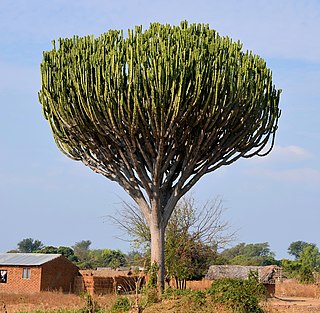
Euphorbia ingens is a species of flowering plant in the family Euphorbiaceae. It is native to dry areas of southern Africa. It is popularly known as the candelabra tree or naboom, and its milky latex can be extremely poisonous, and a dangerous irritant.

Euphorbia balsamifera is a flowering plant in the spurge family Euphorbiaceae. It is distributed from Arabian Peninsula to Sahara and Canary Islands. It is the vegetable symbol of the island of Lanzarote.

The Huntington Desert Garden is part of The Huntington Library, Art Collections and Botanical Gardens in San Marino, California. The Desert Garden is one of the world's largest and oldest collections of cacti, succulents and other desert plants, collected from throughout the world. It contains plants from extreme environments, many of which were acquired by Henry E. Huntington and William Hertrich in trips taken to several countries in North, Central and South America. One of the Huntington's most botanically important gardens, the Desert Garden brought together a group of plants largely unknown and unappreciated in the beginning of the 1900s. Containing a broad category of xerophytes, the Desert Garden grew to preeminence and remains today among the world's finest, with more than 5,000 species in the 10 acre garden.

Euphorbia grantii is a species of succulent plant in the family Euphorbiaceae.

Euphorbia hirta is a pantropical weed, possibly native to India. It is a hairy herb that grows in open grasslands, roadsides and pathways. It is used in traditional herbal medicine.
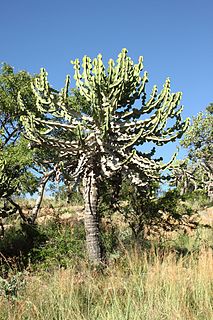
Euphorbia cooperi is a flowering plant in the Euphorbiaceae family. It is commonly called Transvaal candelabra tree or bushveld candelabra euphorbia, and is found in South Africa.

The North-West University Botanical Garden on the Potchefstroom Campus of the North-West University (NWU) is the only botanical garden in the North West Province of South Africa. The Garden spans just under three hectares and is open to the public.

Euphorbia trigona is a perennial plant that originates from Central Africa.

















